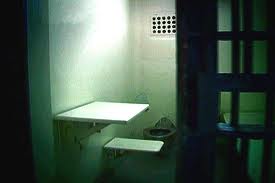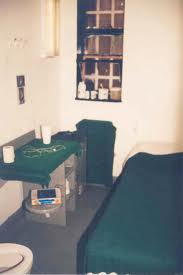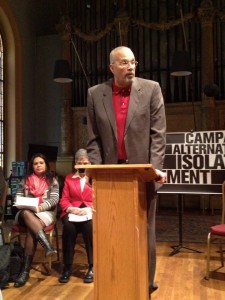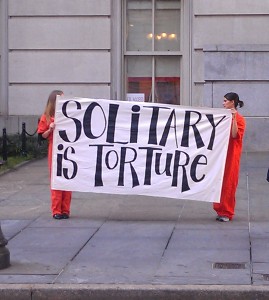Compiled by Fran Geteles-Shapiro.
February 26
Former Guantánamo detainees, with the support of the Center for Constitutional Rights and the Berlin-based European Center for Constitutional and Human Rights (ECCHR), have urged a French judge to subpoena Geoffrey D. Miller, a former Guantánamo Commander to explain his role in the torture and other serious mistreatment of former detainees. They argue that Miller implemented techniques designed to “soften up” detainees, including sleep deprivation, extended isolation, forcing detainees to stand or crouch in “stress positions,” stripping detainees and exposure to extremes of heat and cold. http://www.ccrjustice.
http://www.ccrjustice.org/
February 25
During a hearing before the Senate Judiciary Subcommittee on the Constitution, Civil Rights and Human Rights, Assistant Majority Leader Dick Durbin (D-IL) called for an end to the use of solitary confinement for juveniles, pregnant women and those with serious and persistent mental illness. He also urged further reform of the detention practice so the United States can protect human rights, and improve public safety. http://www.durbin.
According to reports from inside ADX in Florence, CO, eight to nine people held in the super-secret H-Unit are on hunger strike and are being force-fed. One of the men, who’s been isolated for more than 10 years, since he wrote a letter to an imprisoned Muslim man in Spain, has filed a civil action that challenges his extreme confinement on the grounds that it violates his constitutional right to due process. He also claims the FBI is heavily involved in managing H-Unit, with its authority overriding that of BOP administrative staff even though by law the FBI is not authorized to run prisons in the U.S. http://solitarywatch.com/2013/
February 20
Rick Raemisch the new executive director of the Colorado Department of Corrections spent one day and night in solitary confinement. He describes his reactions and his new commitment to reform. But, while recognizing his sincerity, critics have also raised questions about whether the reforms he has already made are truly meaningful citing the facts that: 1) there is a problem with a very narrow definition of mental illness; 2) adequate care and treatment have not been provided; and, 3) people in the CO prisons with mental illness are still spending almost all their time alone in their cells, even though they are now in “treatment” units. http://www.nytimes.com/
Russell Maroon Shoatz, now 70-years-old, was released from solitary confinement into the general prison population at a State Correctional Institution in PA, ending more than 22 consecutive years in solitary confinement. He had been placed in solitary due to his work with the Pennsylvania Association of Lifers to abolish life-without-parole sentences. In 2013 he sued on the grounds that his placement and treatment in solitary confinement was a violation of the Eighth Amendment to the U.S. Constitution. Both national and international advocates had fought for his release. http://
February 19
The New York Civil Liberties Union and the New York State Department of Community Corrections (DOCCS) announced an unprecedented agreement to negotiate reforms to the way solitary confinement is used in New York State’s prisons. The state will take immediate steps to remove youth, pregnant women and developmentally disabled and intellectually challenged people from extreme isolation. The state will also adopt sentencing guidelines and set maximum limits on isolation-sentence lengths – both for the first time. A man who was formerly held in solitary and was a plaintiff in the lawsuit which led to this agreement said, “This agreement has the potential to change DOCCS’ focus to treatment, not just punishment, so some good will come of our time in prison.” http://www.nyclu.org/
A panel of scientists at the American Association for the Advancement of Science’s recent meeting discussed some possible neurological factors behind the devastating psychological impacts of solitary confinement: 1) because proper functioning of the brain depends on daily sun exposure, the denial of access to sunlight interrupts circadian rhythms which can lead to depression; and 2) the hippocampus, which is involved in memory, geographic orientation, cognition and decision-making has been shown to shrink in the brains of people who are depressed or stressed for extended periods. The researchers note that these potential sources of damage would seem to make people who are in prison less equipped to re-enter society, and thus policies supporting them are unwise as well as inhumane. http://www.
February 16
A new Intensive Mental Health Unit has been opened at the Maine State Prison which includes 32 beds with a staff of about 16 people. The new unit will provide programs, including recreational therapy, music therapy and art therapy. And the focus will be on recovery. It is hoped that improvements in the care of mentally ill people in the prison will result. However advocates have pointed out that there are still too many people in the prisons who are not receiving timely mental health services. http://www.
February 12
Suicide is the most common cause of death in U.S. jails. A comprehensive study published by the American Journal of Public Health found that individuals in New York City jails who are sent to solitary confinement are nearly seven times more likely to try to hurt or kill themselves than those never assigned to solitary. Youth diagnosed with serious mental illness accounted for the majority of the self-harm acts. And many hurt themselves in an effort to avoid time in solitary. http://www.
February 11
The Bureau of Prisons has established a “High Security Mental Health Step-Down Unit” at the penitentiary in Atlanta, GA. which is designed to provide substantial long-term care and treatment for high-security mentally ill incarcerated people. The program is adequately staffed with mental health professionals – i.e. for the 20 men expected to be held there, there are two psychologists, a psychiatric nurse and at least two other mental health professionals and who are devoted entirely to the unit so the men have continuous access to them. http://www.theatlantic.
The State Senate Judiciary Committee of Kansas is considering legislation which would automatically confine individuals with a sentence of death or life without the possibility of parole to solitary confinement. Supporters contend that segregating the worst and most dangerous incarcerated people would make it safer for the overall prison population. But the Kansas Dept. of Corrections is objecting to the bill because it will be too costly and because it would create a dangerous environment for correctional officers. A spokesperson for the ACLU also objected because of the detrimental psychological effects of solitary confinement. http://cjonline.
A bill has been introduced in the CA assembly that would rein in the use of indefinite detention in solitary confinement in California prisons. Under the bill, SHU terms for administrative reasons would be capped at 36 months. And good behavior credits, which allow individuals to earn shortened terms for complying with prison rules, will be restored for people who are in SHU for administrative reasons. http://www.asmdc.org/members/
February 10
The man who killed the former Director of Corrections in CO following his release directly from solitary confinement had, prior to that killing, forced a pizza delivery driver who he also killed to record a confused and rambling statement that seemed to denounce prison officials for putting people such as himself into solitary. http://www.
February 6
A woman who was kept in a filthy, isolated New Mexico jail cell for months at a time, was often denied treatment for her mental illness, and was denied feminine hygiene products for lengthy stretches has reached a $1.6 million settlement with the county where she was held. The settlement with also stops the county from holding people in a certain isolated cell for more than 48 hours. http://www.
After controversy over its use of solitary confinement, the Toledo Juvenile Home was closed by Ohio Gov.Branstad.But a Polk County judge has declared the closing unconstitutional and has ordered the facility re-opened. http://www.kcautv.
February 4
Two former members of the Russian feminist rock band, Pussy Riot, who are touring the US after being released from a Russian prison spoke at a human rights concert organized by Amnesty International. In addition to calling on President Barack Obama to increase pressure on Russia over alleged human rights abuses there, they said they will also act for the rights of the incarcerated people in the United States. They plan to visit prisons and meet with nonprofit organizations to learn about the issue of solitary confinement in the U.S. http://america.aljazeera.
Incidents where corrections staff used force against individuals in the NYC jails have tripled between 2004 and 2013. Meanwhile, prison officials downplay the number of traumatic injuries from these events and from internal fighting among the people held in the jails. They also downplay injuries requiring hospitalization – many of which they attribute to falls or work related injuries. It is noted that the role of the excessive use of solitary confinement adds to the violence. http://www.
February 3
Opponents of efforts to reform the use of solitary confinement in jails and prisons are worried that the violence at the jail facility on Rikers Island will get worse. They cite statistics that there were 73 stabbings and slashings in 2013, slightly up from the 71 in 2012 and a major spike from the 38 recorded in 2011. They attribute the increase to gang wars within the jail and to mental health professionals having individuals released from solitary because of concern for their mental health. They also note that there are many people waiting to serve their punishments in solitary (“the bing”) because there are not enough available spots. http://www.nydailynews.
Maryland legislators introduced bills, calling for an independent third-party review of correctional facilities relatign to “isolated confinement” requiring access to facility data, and calling for recommendations on specified topics (including “diverting” youth and people with serious mental illness) after the study is completed. The preamble of the bill cites statistics on the harms and overuse of solitary confinement. http://mgaleg.
January
A report by John Marshall Law School includes accounts of the extreme isolation experienced by some individuals in immigration detention, and explores why a September 2013 Immigrations and Customs Enforcement (ICE) directive falls short in protecting vulnerable detainees, especially those with mental or medical illnesses. Recommendations call for greater enforcement of regulations, greater oversight and transparency, and special attention to the treatment of vulnerable populations. http://www.jmls.
The ACLU has released an online toolkit outlining how LGBTI advocates and directly affected individuals can leverage the Prison Rape Elimination ACT (PREA) to protect one of the most vulnerable populations in prison. https://www.aclu.org/
A new report by the Youth Justice Clinic of Cardoza Law School, RETHINKING RIKERS: MOVING FROM A CORRECTIONAL TO A THERAPUTIC MODEL FOR YOUTH argues that there should be a fundamental shift from a punitive to a therapeutic approach with practices that are specialized for and dedicated to youth rehabilitation, beginning with “the pressing need to eliminate the use of solitary confinement.” The report notes that it does not work to reduce aggressive, violent, impulsive or disobedient behaviors. Furthermore, among the detrimental effects of this practice they mention increased rates of recidivism. http://www.
Data provided in response to the Texas Civil Rights Project’s information request shows that, while the overall population in administrative segregation has decreased by 14% since 2011, the number of individuals with mental illness in administrative segregation has increased by 17%. They now make up 32% of the administrative segregation population. This % change is due partly to the smaller population, but also to more mentally ill people being sent to solitary. A bill requiring third party review of adult and juvenile administrative segregation practices and policies—passed in the 2013 legislative session with overwhelming support, has yet to be implemented. Since lawmakers had increased resources for mental health services and expressed intent to prioritize mental health in both incarcerated and free populations, there appears to be a possible discrepancy between legislative intent and implementation. http://
A recently issued policy from the American Public Health Association concludes that: 1) patients whose medical or mental health conditions contraindicate placement in segregation should be categorically excluded from solitary confinement, as should juveniles; 2) correctional authorities should implement policies that eliminate solitary confinement for security purposes unless no other less restrictive option is available to manage a current, serious, and ongoing threat to the safety of others; and, 3) punitive segregation should be eliminated. http://www.apha.
A recent position statement by the Society for Correctional Physicians acknowledges that prolonged segregation of incarcerated people with serious mental illness, with rare exceptions, violates basic tenets of mental health treatment. Individuals in prison who are seriously mentally ill should be either excluded from prolonged segregation status or the conditions of their confinement should be modified in a manner that allows for adequate out-of-cell structured therapeutic activities and adequate time in an appropriately designed outdoor exercise area. http://


 In the meantime, Pendergrass expects there will be some who feel the current deal goes too far, just as others believe it does not go far enough. He did not specify where the “pushback” is likely to come from. But in the past,
In the meantime, Pendergrass expects there will be some who feel the current deal goes too far, just as others believe it does not go far enough. He did not specify where the “pushback” is likely to come from. But in the past, 


Follow the #HALTsolitary Campaign